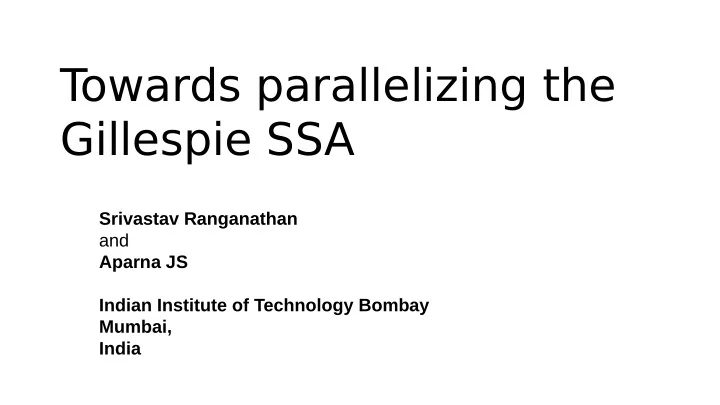

T owards parallelizing the Gillespie SSA Srivastav Ranganathan and Aparna JS Indian Institute of Technology Bombay Mumbai, India
Gillespie Algorithm • A stochastic simulation approach to study the time evolution of a system of reactions (processes) • Each reaction occurs at an average rate • The abundance of various species and their rates decide the propensity of each event to occur • Many independent trajectories are generated to compute ensemble averaged statistical quantities
Where is it used? • In biological systems • Outcomes of cellular processes are driven by stochasticity at a molecular level • Deterministic approaches cannot capture the inherent randomness of biological systems
The algorithm •
Initialize the system (individual rates) Compute the probabilities of going from one state to another (p i ) Generate the fjring time for the next reaction to be fjred Select the next reaction to be fjred Most expensive of all these steps
Selecting the event to be fjred • Draw a uniform random number ran1 Fire Fire Reaction 4 Reaction P1+P2 1 P1+ P2.. P1+P2+.. ….P8 P3 +P4 0 P1 P1+ P2 • Update the system confjguration based on the fjred reaction (abundance, rates etc) • Update the time based on the exponential distribution of wait time between events (
This search for the next event to be fjred is really expensive if there is a large reaction space!
Our attempt (Scheme 1, One-One communications) W1 MPI_SEND Master MPI_SEND W2 • Owns the transition probability matrix MPI_SEND • Keeps the system confjg updated Worker Nodes: W3 Receive blocks of the search space Identify the event to be fjred MPI_REDUCE (MPI_MAX) Pass the event info into a bufger, if a hit is received
Our attempt (Scheme 2, Collective communication) W1 MPI_SCATTER Worker Nodes: Receive blocks of the search space Master MPI_SCATTER Identify the event to be fjred • W2 Owns the transition Pass the event info into a bufger, probability matrix if a hit is received MPI_SCATTER • Also performs part of the search W3 • Keeps the system confjg updated MPI_REDUCE (MPI_MAX)
What worked ● Our naïve serial code was optimized to minimize cache misses (a speedup of 1.5 times) ● The MPI code did give us correct results (compared with the serial code and analytical results!) ● Exposed us to a new way of thinking
What did`nt? ● MPI codes show a speedup from 1 to 3 cores but scale poorly ● Performance slows down at 5 processes or more ● Probably due to huge communication overhead in our code ● Possibly revisit the whole algorithm or use a more parallel-friendly algorithm!
Thank You!
Recommend
More recommend